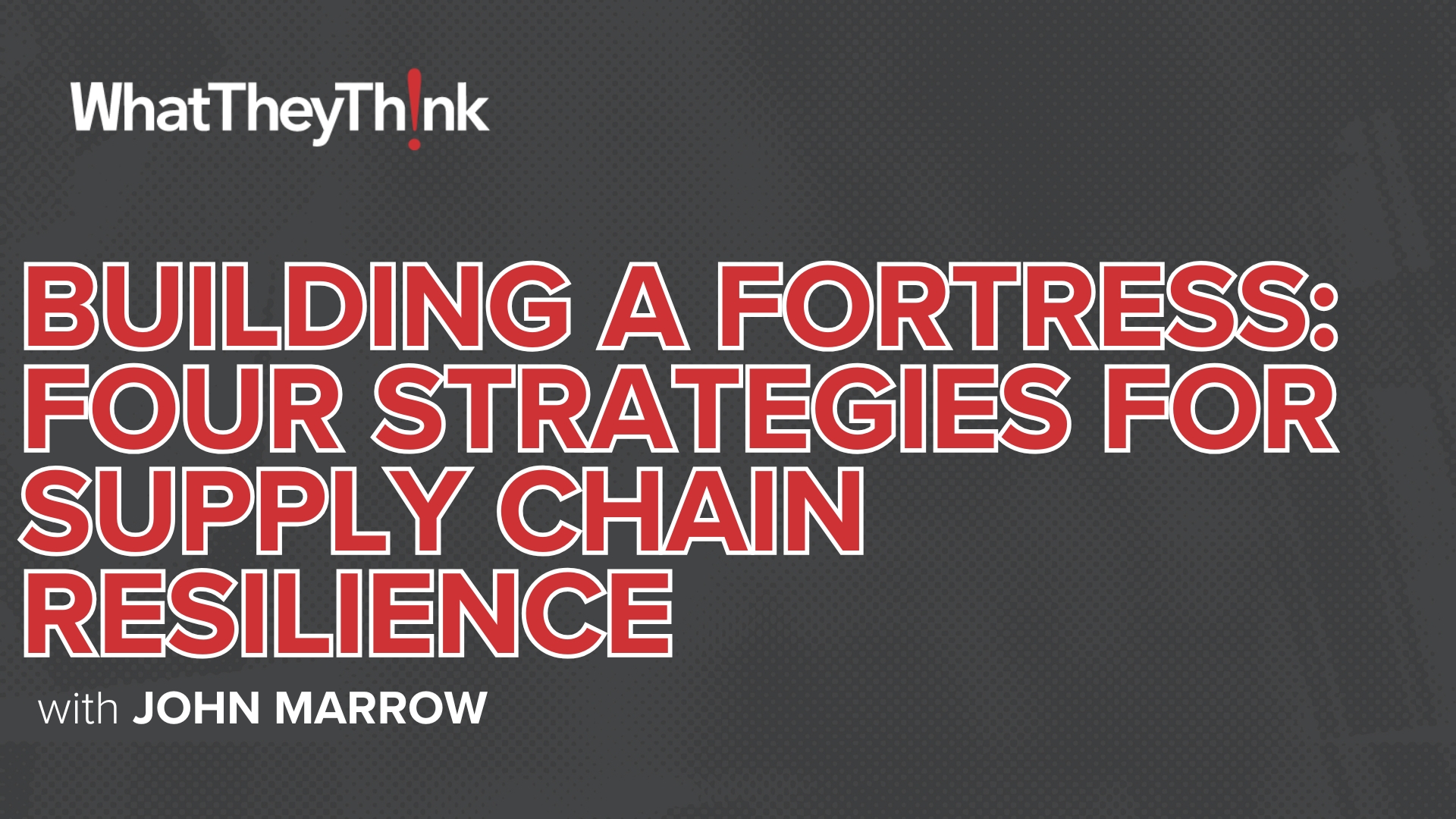Commentary & Analysis
Displaying 2101-2200 of thousands of articles
Insight You Need. Analysis You Trust.
Get the trusted insights you need to understand our evolving industry and emerging trends. Become a Premium Member.
Key Thermal Print Segments Poised to Rebound in 2021
COVID-19 has had a profound effect on thermal print equipment and consumable sales, but these will return to positive growth in 2021, according to the Smithers study The Future of Thermal Printing to 2025. This article summarizes some of the main trends identified in the study.
Is the Apparel Industry in the Midst of a Systemic Change?
In a recent TexProcess/TechTextil webinar, panelists discussed what is happening with respect to the textiles and apparel supply chain, especially what has been accelerated by the pandemic. Has there been a sourcing shift? Is there a balance shift between Western and Asian sources? What key elements do brands and suppliers need to address to bring about needed systemic change? How many are even capable of driving systemic change? These were some of the questions and issues discussed in this very interesting session.
Around the Web: Lockdown Lyrics. Poet Praise. Sneaker Snafu. Tinseltown Typing. Expensive Ephemera. Art Aging. Prying Pixels. Picturephone Promo. Transdermal Transponder. Busy Beaver.
The musical British family who wittily chronicle lockdown life. Marking the bicentenary of John Keats’ death. Adidas seeks to ditch its acquired Reebok brand. “Hot typewriter action” scenes from top movies. The booming market for “nonfungible tokens”—digital art, ephemera, and media. An oil painter who specializes in lenticular art. The “spy pixels” in email messages that track you. A promotional film for 1964’s pre-Zoom Picturephone, a commercial dud. Why “Zoom fatigue” is a real thing. The aptly named DangerousThings lets you inject chips and sensors into your body, for some reason. A “rescue beaver” is compelled to dam up open spaces—indoors. All that and more in WhatTheyThink’s Martian miscellany.
Commercial Screen Printing Employees—2010–2018
In 2010, there were 57,674 employees working in US screen printing establishments (NAICS 323113). By 2018, that number had increased +12.4% to 64,840. In macro news, seven “recovery indicators” for parts of the economy most acutely impacted by the pandemic.
Leveraging the Evolution of High-Speed Inkjet in Today’s Digital World
Concerns about data security have escalated in the COVID era, making some people wary of digital engagements. As a result, traditional print-based communications remain effective and can sometimes enable businesses to stand apart from their competitors. This article explores how print service providers can use high-speed inkjet equipment to their advantage
New Year, New Adventures: Marc Olin, Ken Garner and Michael Makin Make Their Exits…for Now
Cary Sherburne speaks with three printing industry veterans who have chosen to make a new beginning: Marc Olin, former COO at EFI; Michael Makin, former CEO of PIA and EVP at PRINTING United Alliance; and Ken Garner, former SVP for Content Creation at the Association for Print Technologies. As they start the new year with new adventures, we wanted to give them special recognition for all of their contributions and years of service to the industry.
Imageco Gears Up for Sustainable Digital Print Production with the New HP Latex 800 Series
Imageco is on a mission to greater sustainability, driven by their own sustainability concerns and customer demand. In this article, textiles expert and WhatTheyThink contributor Debbie McKeegan explains how the company is pursuing these goals with the latest HP Latex technology.
drupa 2021 Essentials of Print: Woodworking Surface Decoration—Digital Horizons within Reach?
A new focus on mass customization and a growing demand for sustainability are causing digital printing to become more vital in one area of industrial printing: woodworking. We expect to see continued growth in the woodworking industry as a whole, including categories like furniture. This article will focus on two key areas where industrial printing has a significant impact: digital décor paper for laminates and direct printing in the woodworking industry. Ron Gilboa explores the opportunity and technology that is driving this innovation to be adopted.
Direct Mail Lessons from After Five Tuxedo Rental
A closer look at a case study from Postcard Mania with takeaways for other print providers about boosting their own direct mail business.
Print Business Front Office Modernization: Part 1—Guiding Principles
This article, the first of a five-part series on the modernization of your print business front office, starts with some guiding principles and then discuss the various “objects” that are managed by the carpeted area of your plant.
The Expertise to Innovate with New Inkjet Applications: NIXKA
NIXKA may be the new kid on the block, or are they? They actually have 30 years of expertise in developing ink and material jetting solutions, with an impressive track record. More importantly, they have the right philosophy.
Get Ahead of the Tech Curve: Smart Signage Expands Experiential Marketing Opportunity
Connecting brands to consumers is incredibly important, and in the print and sign industry, it’s all about making consumers feel a part of something larger than themselves. In this article, guest contributor Larry Oberly, President & CEO of SpeedPro, explains the advantages of SpeedPro’s InfoLnkX NFC application for creating interactive, touchless, smart signage.
Executive Q&A: John Mills, CEO of Xaar
John Mills, CEO of Xaar, talks about the company’s rebranding strategy, the new ImagineX printhead platform, and the “new Xaar.”
European Environmental Legislation for Print
Environmental considerations are becoming more and more important factors in buying decisions of consumers and businesses, and this is supported by environmental legislation. This article by European section editor Ralf Schlözer looks at the latest developments in environmental legislation for print in Europe.
Are Bio-Based Plastics the Answer to Increased Sustainability? The Jury Is Still Out…New Research Is Encouraging, but Consumer Behavior Also Has an Important Role to Play
A push toward a more sustainable textiles and apparel industry is underway, largely driven by consumer demand, and, to some extent, by brands who are working to restructure their supply chains post-pandemic. Key considerations include not only the adoption of more digital technologies, about which we have written extensively, but also the further development of fabrics created from bio-based materials, and a significant change in consumer behavior with respect to their wardrobes. Learn more about the pros and cons of bio-based materials, some of the emerging developments, and behavior changes that can reduce your personal textiles-based environmental impact.
There’s Gold in Those Hills: Are You—Or Your Salespeople—Doing Enough Prospecting?
If you want to make more money—and minimize the risk of making less—you should do more prospecting. Contributor Dave Fellman looks at the prospecting process and how to arrive at the ultimate goal of prospecting: a first meeting with a potential new customer.
December Printing Shipments—One Last Unexpected Twist for 2020
In December 2020, in one last, end-of-the-year rally, printing shipments grew from $7.0 billion to $7.17 billion.
Around the Web: Mars Meeting. More Monoliths! Wicked Wheels. Safe Socializing. Modular Mask. Vegan Vestments. Ovine Ovation. Carbon Conundra. Textile Traffic. Saloon Sounds. Audio Oracle. King Cat.
A new monolith appears—briefly—in Congo. A guy replaces his bicycle wheels with giant sawmill blades. The latest in “mask tech”: the egg mask. First, they came for the silkworms—and now…the sheep? Sheep Inc. says one key to carbon sequestration is…wait for it…sheep. Some other potential solutions for dealing with carbon and carbon dioxide. Textile and apparel imports are on the decline. A website lets you simulate the ambiance of your favorite bar. RIP Rupert Neve: the inventor of the mixing console. A housecat joins “Godzilla vs. Kong” and the related carnage. All that and more in WhatTheyThink’s carbon-heavy miscellany.
Is Your Company Self-Aware Enough to Change Successfully?
The writers and publishers who chronicle the world of business have been a buzzword factory for the last four decades. There’s no need to list them here, but probably the most frequently mentioned topic in the last few years has been how to change an organization into something that has a better chance of surviving and thriving. In this article, Wayne Lynn discusses the importance of becoming self-aware. Knowing what your strengths, weaknesses, and blind spots are provides the best starting point for successful change. Read on…
Five Textile Design Archives Offering Original Vintage Patterns for Interior Furnishings and Fashion
Over the centuries, fine art and textile design have always been close companions. Today's textile designers can take advantage of a number of outstanding archives of vintage designs that can act as inspiration, or be licensed for use. Textiles expert and WhatTheyThink contributor Debbie McKeegan highlights a few.
Want Growth? Then Automation is What You Seek!
The increase in digitally driven on-demand printing, combined with the flexibility of online ordering, has greatly increased the number of print orders—often at lower print volumes—that a print service provider must manage and produce. This article explores how PSPs that increase their levels of automation now may be able to reap disproportionate rewards in the future.
Prepress Automation Made Easy
If you have taken the first steps to automating your workflow, you will have seen significant benefits from software you had likely already invested in. In this article, sponsored by EFI and the second in a series, explores how to take your workflow automation to the next level by examining your prepress operation to uncover bottlenecks that require extra labor and slow the production process.
Printing Outlook 2021: Profitability, Planned Investments, Hiring
WhatTheyThink’s Fall 2020 Business Outlook Survey asked print business executives and owners about their 2020 business conditions, business challenges, biggest perceived opportunities, and investment plans, as well as opinions of virtual events and their 2020 hiring plans. The results of this survey are included in WhatTheyThink’s Printing Outlook 2021 special report. Here are some of the top-level findings from that report.
Considering a Non-Print-Specific MIS/ERP
If you run a print manufacturing business, chances are you should invest in a print-specific MIS/ERP solution. However, proceed carefully if you insist on adopting a generic MIS/ERP software solution. Don’t get caught up in paying for customizations that are expected features for a print business.
Packaging Prepress Services Adapt and Expand
As packaging requirements change and the transition to digital printing increases, who will pick up the mantle?
Main Routs: Options for Adding Traditional Signmaking Capabilities
An introduction to one of the essential tools for traditional signmaking: the CNC router.
So…Someone Wants to Buy Your Software
Selling software is not like selling hardware. Pat McGrew offers tips and suggestions for acquiring the skillset needed to successfully sell software solutions.
European Print Industry Snapshot: Germany
In this bimonthly series, WhatTheyThink is presenting the state of the printing industry in different European countries based on the latest monthly production numbers. This week, we take a look at the printing industry in Germany.
Wield the Data Sword: How to Use the Growing “Datasphere” to Your Advantage
The successful curation of the data springing from your business operating systems has the potential to unearth rich clues for improved growth and performance. However, it can be a daunting task to know where to start and where to stop. Preston Herrin offers a balanced approach to metrics and analytics and understanding how to apply them in your business to advance a data-driven culture and galvanize a new agility.
Printed Electronics: High Value, High Touch
From life-saving medical devices and rapid COVID-19 tests, to dashboards and musical instruments, printed electronics are a high-value opportunity. To exploit the opportunity requires high-touch engineering and customer support. Contributor Pete Basiliere details the challenges.
Around the Web: Cat Court. Color Creation. Sustainable Suds. Apt Appliances. ’Acked Aquifer. Manufactured Meat.
A Texas attorney tries to prove he is not a cat. A brand-new shade of blue is now available for painting. A new business makes sustainable laundry detergent. A handy visual aid to help you determine which appliance is best for which use. A water treatment plant gets hacked—with almost disastrous results. 3D-printed steaks. All that and more in WhatTheyThink’s kitten filter miscellany.
Commercial Printing Employees (Less Screen and Books)—2010–2018
In 2010, there were 380,107 employees working in US establishments in NAICS 323111 (Commercial Printing–Except Screen and Books). By 2018, that number had declined -13.5% to 328,845. In macro news, the Consumer Price Index (CPI) increased 0.3% in January, or 1.4% over the last 12 months.
Checking the Mail: A 2020 USPS Year in Review
Christine Erna looks at the problems that the United States Postal Service had to contend with in 2020—and looks ahead to 2021.
Pre- and Post-COVID Trends Drive Changes in Wide-Format Print Software
The COVID pandemic has accelerated some older—and created other new—trends an demands for automation and other wide-format printing software.
In Many Companies, New Digital Workflows Will Outlast the Pandemic
Some of the digital processes that were implemented out of necessity when the pandemic hit will likely persist even once the pandemic has subsided. This article discusses the implications of business process digitization and cites recent research from Keypoint Intelligence to explore considerations for the future.
Why Customer Journeys Matter More During a Pandemic
Even if printers are not in the market for a new marketing automation system, tracking the new and updated features of available platforms provides insight into where marketing is going and what they (and their customers) need to watch, both now and in the future. One such change is the increased use of AI to speed and simplify the identification and understanding of customer journeys. As COVID-19 ramps up and consumers tighten their belts (again), the timing couldn’t be better.
Orchestrating Success: Advice from Trade Print and Service Leaders
Every motion you make in your business sets the tone for the ultimate performance of the supply chain. Whether you are a manufacturer/service provider shepherding the genesis of the supply chain or a reseller/distributor working bi-directionally within the supply chain, success hinges on advanced collaboration in order to deliver on customer expectations. Preston Herrin takes our annual look at trade brokering and distributing.
So Your Print Sales Team Isn’t Very Technical
Technical skills are important in every functional area of your print business and sales is no exception. Every salesperson needs to be able to calmly and strategically uncover business challenges and communicate these challenges to your technical resources without limiting potential solutions or setting unreasonable expectations with the customer.
Is There a First-Mover Advantage for Inkjet? Five Inkjet Early Adopters Share Their Experiences
Why would a printing business want to be an early adopter and take a risk on unproven technology? Inkjet Insight’s Elizabeth Gooding spoke with five technology leaders using inkjet in quality-sensitive operations about their experiences as pre-release adopters of production inkjet presses.
Johnson’s World—Ask Your Customers to Be Your Valentine
Why do we give a Valentine gift to a loved one? To make that person feel loved and appreciated. Don’t you want your clients to feel loved and appreciated as well? Send them a Valentine’s Day card!
Inkjet for Corrugated Is Not Just for Short Runs
Here are two corrugating companies that have found that production inkjet in place of the litho laminate process makes great operating and financial sense.
HP Indigo and Esko—Driving Labels and Packaging Automation into the Future
2020 was a remarkable year for labels and packaging, particularly digitally printed pressure-sensitive labels, sleeves, flexible packaging, and other high-demand applications for the health, pharma, household, and food industries. The demand for digitally printed labels and packaging has grown significantly during the pandemic and customers are investing more in workflow and automation to manage the load. In this article, sponsored by HP, we spoke with HP Indigo’s Maya Poleg, Head of Products and Solutions, and Esko’s Chuck Ravetto, VP & General Manager, Supplier Solutions, to hear their perspectives on their long-standing relationship, and where they believe the industry is heading.
Sizing the European Printing Industry: The Nordic Countries
This is the sixth part of a series of articles on the size of and trends in the printing industry in key countries in Europe. The Nordic countries in Europe include Denmark, Finland, Norway, and Sweden. Together, they account for €4.7 billion in revenues in the graphic arts industry and more than 25,000 employees. Combined, the Nordic region would constitute the sixth largest printing industry in Europe, closely followed by Spain. There are additional print segments, as well, adding to a total print market of close to €7.5 billion
As Goes the Industry, so Goes the Trade Associations—January 2021 M&A Activity
Printing United Alliance Sets the Standard, H.I.G. Bags Action, BluEdge Expands, and more…
Around the Web: Spamming Spinach. Novel Novel. Glorious Graphene. Sleeping Sacks. Gargoyles Galore. Sawing Celebration. Calculating Carsey. Weird Waking. Amish Auto. Disappearing Doll.
Spinach can now send emails. A novel only uses the words spoken by Ophelia in Hamlet. More graphene news! Recycling potato chip bags into sleeping bags for the homeless. Colgate introduces new aluminum toothbrush with replaceable heads. The origin of gargoyles. 100 years of the “sawing a woman in half” trick. “A Lego white noise” playlist. A “smart toilet seat” for measuring vital signs. A teen, in a coma since March 1, 2020, is about to wake up to a strange new world. Attaching buggy wheels to a Dodge Challenger, for some reason. Texas issues an Amber Alert for Chucky from “Child’s Play.” All that and more in WhatTheyThink’s emailing vegetable miscellany.
Q3 2020 Profits—Back on Track…Sort Of
Annualized printing industry profits for Q3 2020 rose from -$1.92 billion to -$1.19 billion. That’s still really low, but at least it’s headed back toward positive territory.
Using Data to Improve the Power of Personalization
Print’s days of channel dominance are most certainly over, but it remains a powerful means of communication. Digital is here to stay, so it is more important than ever for printed communications to be fresh and innovative. This article explores how data can be leveraged to create personalized print campaigns that encourage engagement and increase revenues.
Exploring the Possibilities of Interior Décor Printing with HP—Live from Barcelona with Leading Industry Experts
Textiles expert and WhatTheyThink contributor Debbie McKeegan recently attended a very interesting session on the possibilities digital print offers for home décor. Presenters included a variety of industry experts with excellent insight. The piece also includes links to replays in case the reader wants to hear directly from the experts.
HP Introduces New Latex and PageWide XL Portfolios
HP updates its Latex roll-to-roll portfolio with four new units that bring white ink printing, new inks and printheads, and a renewed commitment to sustainability. Additionally, HP has launched a new Latex Print and Cut line and refreshed its PageWide XL units for the technical printing markets.
Easy Workflow Automation for Printing Companies of All Sizes: Getting Started Today!
Print businesses large and small need to start automating processes to save time and money and increase throughput. But for many smaller print businesses, automating their printing workflow can seem like a daunting—and expensive—challenge. This article, sponsored by EFI, show how that’s a misconception that is holding businesses back from greater profitability, and that getting started with workflow automation is much easier than you might think.
Direct Mail Retargeting Goes Mainstream
Direct mail retargeting is starting to go mainstream. In this post, we look at some key supporting data for growth in the direct mail retargeting market and the approaches used by three printers offering these services.
Print Software and 2021’s Business Trends
Working from home, data as an asset, and automation: three business trends and their specific impact on print businesses.
Serious Questions Around the USPS and Rates
If you’re a commercial mailer of flats and periodicals, brace yourself. Customers are facing an unexpected and steep increase in USPS mailing rates sometime this summer — even while service standards remain miserably low.
Are You Ready for Compliance?
Since the emergence of the original European Data Protection Act and the follow-on General Data Protection Regulation (GDPR), building a privacy protocol has been a topic in companies around the world. The codification of the California Consumer Privacy Act (CCPA), however, changed the trajectory of the conversation. It is far-reaching and touches all of us. Pat McGrew interviews University of Colorado Professor Linda Fried to provide background and guidance.
Taking Color Management to the Next Dimension
Color Management is the critical part of any reproduction process, especially as it relates to brand identity. We have good tools today, but as print applications expand beyond conventional media—for example, to packaging and industrial applications—we are starting to outgrow them.
European Print Industry Snapshot: Lithuania
In this bimonthly series, WhatTheyThink is presenting the state of the printing industry in different European countries based on the latest monthly production numbers. This week, we take a look at the printing industry in Lithuania and the Baltic states.
Virtual Events: The Pros and Cons
2020 and a good part of 2021 will be seen as the time of virtual events. It was either that or put everything on hold, which clearly was not an option. There was great hope that we would be back to in-person events by spring of 2021, but one by one, scheduled events such as drupa and Interpack, FESPA, TechTextil/TexProcess, and more were either cancelled, converted to virtual events, or postponed until late summer or fall. We spoke to a number of folks—organizers, sponsors and attendees—to get their views about the value of these events. We also included some virtual event questions in a broader survey.
Behind the Scenes with HP PageWide
HP has spent the past four decades not simply investing in inkjet research and development but perfecting it. Hear from subject matter experts on timely topics, including a customer spotlight on the new HP PageWide Web Press T250 HD.
Around the Web: Color Quest. STEM Stamps. Cool Codes. Retro Railroad. Clothing Computations. Tea Tints. Sleepless Science. Blade Becalming. Missing Monarchy. Disgusting Dessert. Pasta Passion.
In search of the original “Apple Beige.” The USPS launches Star Wars stamps to promote STEM learning. How COVID made QR codes cool. A Chinese railroad was derailed when Adobe killed Flash. A man quantifies his wardrobe. Beautiful tea bag art. First Night Effect: why it’s hard to sleep in a strange place. “Chinese Knife Massage.” Gender-neural playing cards. “Everything bagel-flavored ice cream.” Perfect for Valentine’s day: pink, candy-flavored mac and cheese. All that and more in WhatTheyThink’s stock shorting miscellany.
Commercial Printing Employees—2010–2018
In 2010, there were 499,622 employees working in US establishments in NAICS 323. By 2018, that number had declined -12.2% to 438,516. In macro news, real GDP increased at an annual rate of 4.0% in Q4 2020.
Sustainability and Eco-Friendly Textiles: Developments That Will Define the Next Decade for the Textile and Printing Industry
Sustainability is moving to the top of the to-do list in textiles and apparel as we as we enter a new decade and beyond. Sometimes it seems like not much has changed, but in this informative article, textiles expert and WhatTheyThink contributor Debbie McKeegan lists many of the sustainability achievements we saw in 2020.
Identifying New Business Opportunities in a Challenging Environment
Even with vaccines being distributed, it will likely be quite some time before the coronavirus becomes part of our history rather than our daily reality. Much like the virus, though, PSPs are proving themselves to be quite resilient. This article explores the actions that various printing companies are exploring so they can maintain—or even accelerate—growth as we emerge from the pandemic.
Customer Segmentation in Your Print Business
Understanding your customer segmentation and even more importantly the “jobs” the printed products do for your customers can help you better target your sales efforts. Diversity is a hedge against catastrophic market segment collapse (another lesson of COVID-19).
Marketing Metrics Are Changing — And That’s a Good Thing
Gone are the days of evaluating campaigns largely in terms of response rate, conversion rate, and dollars per sale. When we read case studies, listen to webinars, and browse industry coverage, we see a wider range of marketing metrics being used than ever before. It’s no wonder that 90% marketers now see measurable results from their personalization efforts.
drupa 2021 Essentials of Print—Convergence of Print Markets: Is It Inevitable?
Digital printing has transformed the print world. For a long time, it was restricted to printed documents and photocopying, then inkjet went after the label market first, followed by the narrow-width packaging market or "small" format. At the same time, in the world of large and very large format, inkjet pushed the screen printing and even the offset process out of the most common jobs. This article looks at the potential for diversifying into a wide variety of print applications.
How Will the Print Industry Change in 2021—and Beyond?
Smithers latest analysis shows that 2020, and the global coronavirus pandemic, have profoundly disrupted the global printing industry. Total value fell from $814.7 billion in 2019, to reach a projected $743.4 billion in 2020. This article explores the major industry trends to emerge in the wake of the pandemic.
European Printing Outlook 2021
2020 showed that we can’t prepare for everything. But still it pays to try. This article covers five trends that will be important for the printing industry in Europe (and beyond) in 2021.
Graphic Arts Employment—December 2020
In December 2020, all printing employment was up +0.7% from November, production employment up +0.1%, and non-production printing employment up +1.9%. So, basically, a holding pattern—although it’s nice that there are no negative numbers…for almost everyone.
Around the Web: Foodie Franklin. Typo Typography. Monospaced Menace. Dense Darkness. Velcro Volume. Visible Vermeer. Tech Toys.
Ben Franklin introduced tofu to the US. A new font designed to facilitate proofreading. Comic Sans…Monospaced! Inside the blackest room. Inventors develop a quieter Velcro. Journey inside an amazingly high-res scan of a classic painting. Fisher Price’s “new” retro gadget toys. A van-based office pod for the work-from-anywhere crowd. Holographic chocolate. All that and more in WhatTheyThink’s winter miscellany.
What Will Be the Role of the Creative Designer in Industry 4.0? Paintbrush to Pixel and Beyond—The Strategic Creative
As Industry 4.0 takes greater hold on the textiles and apparel industry, it is estimated that more than 25% of all work activities will be displaced by automation by 2030. But what does this mean for textile designers? Surely a robot can’t replace a designer! Designers have already moved from paintbrush to pixel, and while they won’t be replaced by robots, their roles will surely change. Read what textiles expert and WhatTheyThink Contributor Debbie McKeegan has to say on the topic!
Leveraging Finishing to Maximize the Effectiveness of Print
Finishing is an important step for nearly every printed document. Ongoing advancements in digital printing capabilities have the potential to elevate finishing to a value-added service. This article explores how print service providers can maximize the effectiveness and profitability of print with today’s finishing capabilities.
Survey: Changing B2B Buyer Expectations You Need to Know
The way B2B buyers make purchases is changing, and PSPs and their customers must change along with them. But it provides opportunity, as well. Results from the latest DemandGen “B2B Buyer Behavior Study.”
Print Software Feature Requests: You’re a Priority, Just Not the Only Priority
Feature requests are popular. The default response to new software to ask for it to be changed to fit the way you specifically think it should fit into your specific environment. “Change your processes to optimize your use of the software” is the one statement that would save the print industry millions of dollars.
Fast Moving Consumer Shifts—Drilling Down to Find the Opportunities
Consumer trends have been shifting for a while. However, the rate of shift is increasing, opening up opportunities for new product innovation and a shift in packaging demands.
A Night at the Opera with Vancouver’s Still Creek Press
Founded more than 30 years ago as a business forms printer, Vancouver’s Still Creek Press has adapted and evolved over the years, adding wide-format printing capabilities and other products and services. A recent project saw the company come to the rescue when the University of British Columbia Opera decided to stage a virtual production.
Does Poshmark’s Overperforming Portend a Shift for the Apparel Industry?
Poshmark (ticker: POSH) shares entered the public market last week, with shares soaring nearly 142%, opening at $97.50 and hitting a high of $104.98, with a Thursday close at $101.50, making it up 141.7%. This kind of feels like the 90s dot-com boom. Will it lead to a bust? The Poshmark CEO thinks not.
European Print Industry Snapshot: Hungary
In this bimonthly series, WhatTheyThink is presenting the state of the printing industry in different European countries based on the latest monthly production numbers. This year kicks off with a look at the printing industry in Hungary.
US Copy Center Establishments—2010–2018
In 2010, there were 6,026 establishments in NAICS 561439 (Business Service Centers [Including Copy Shops]). By 2018, that number had declined to 5,305. In macro news, weekly initial unemployment claims were at 965,000, an increase of 181,000 from the previous week.
Around the Web: Fungal Fashion. Crustacean Craze. Plague Prescriptions. Can Conundrum. Pharmaceutical Favors. Pig Painting. Nacho Narrative. Mesmerized Mantises.
2020 was the “year of the mushroom,” apparently—and lobsters, too. A 16th-century doctor’s plague prevention manual is relevant to COVID. The company out to replace plastic packaging with metal. A collection of the weird swag pharmaceutical reps used to give to doctors. Researchers recently unearthed the oldest painting of an animal. Balloon-based pizza delivery. The history of nachos. Praying mantises watch TV. All that and more in WhatTheyThink’s New Year’s miscellany.
Capturing a Clear “Before and After” Picture of Sales Metrics
A great many industries leverage before and after results because highlighting a contrast can be powerful, inspiring, and attention-grabbing. Savvy print sales organizations understand how to use sales metrics to capture a clear before and after picture. This article discusses the importance of sales metrics and explores how they can be used to make more informed business decisions.
Free Color Chart for Color Management in Digital Textile Printing
If you are a designer working in a larger organization, you probably have access to formal color standards. But there are a growing number of freelancers starting their own businesses, and creating color standards that ensure what gets printed carries out your design intent is not a trivial process. Textiles expert and WhatTheyThink contributor Debbie Mckeegan rides to the rescue with a free color chart to get you on your way.
What Types of B2B Content Win You Data?
B2B buyers are using more pieces of content in their research than in prior years. This means more things you can print and distribute digitally for your customers. But exactly what types of content do they see as valuable enough to register for and for which they are willing to provide information about themselves and their companies?
A Dynamic Print Business
The printing industry is becoming more dynamic—not just as it relates to COVID-19 but in general. Everything is moving and increasing in velocity. Our ability to thrive in this environment requires a dynamic business approach, one that is characterized by constant change. A business must adjust according to its current conditions. This is a path to systemizing a dynamic business, one that is characterized by constant change—but a constant change that doesn’t leave your people behind.
Leadership through the Lens of Paradox
It is often said that the level of thinking (and leadership) that got us to where we are today will not take us to the next level. In this article, Wayne Lynn talks about learning to manage paradox. It requires individual and organizational growth. It is sorely needed in a world beset with pandemics, civil unrest, and political polarization.
Fast Moving Consumer Shifts, or Where’s the Toilet Paper?—Part 1
Consumer behavior has changed at an alarming rate and will continue to change, opening up new opportunities for new product innovation—and packaging.
Flint Group Consolidation of Flexographic Prepress Adds Value for Flexo and Letterpress Customers
On January 7, the Flint Group kicked off the year with an organizational announcement that makes a great deal of sense for its business; in fact, many of us have wondered why it took so long. The company formed a new division, XSYS, which combines Flint Group Flexographic and Xeikon Prepress into a single Flint Group division, led by Dagmar Schmidt as President. Read more for all the details.
Sizing the European Printing Industry: The Netherlands
With €3.1 billion in revenues and more than 17,000 employees, the graphic arts industry in the Netherlands is among the largest in Europe. But there are additional print segments as well, adding to a total print market of close to €6 billion. This is the fifth part of a series of articles on the size of and trends in the printing industry in key countries in Europe.
Bags, Pouches, Trays & Bowls—December 2020 M&A Activity
ProAmpac Brown Bagging It, Alcom Spreads Out, Ebony & The Voice Rise From the Dead, and more…
Around the Web: Picky Preview. Green Gatsby? Correcting Coinage. Programmed Poetry. Programmed Pictures. Cultural Coupon. Satellite Solution. Priapic Programming. Barf Burger. “Chicken Chamber.”
An honest preview of the year to come. The Great Gatsby is now in the public domain—and there is already clamoring for a Muppets version. A new H.G. commemorative coin has a couple of errors. Google’s Verse By Verse uses AI to help us write a poem. DALL·E uses AI to generate images from text prompts. An oral history of Bed Bath and Beyond’s big blue coupon. The origin of the Pez dispenser. The AR version of the New York Times crossword. An often hysterical mashup of North By Northwest and Star Wars. Denmark’s…bizarre idea for a children’s cartoon. McDonald’s China launched a Spam and Oreo burger, for reasons passing understanding. KFC has a combination game console/chicken warmer. All that and more in WhatTheyThink’s New Year’s miscellany.
November Printing Shipments—It Was Nice While It Lasted
In November 2020, after rising for five straight months, printing shipments plunged from $7.63 billion to $7.0 billion.
Strategies for Developing Data-Driven Communications
The customer communication process is becoming increasingly complex. Thanks to ongoing innovations in customer segmentation and data mining, businesses now know more about their customers than ever before. This article explores the latest strategies for delivering data-driven communications.
The Digital Sprint: Simplifying Printed Textile Production to Deliver Increased Sales and a Sustainable Future
A recent report from McKinsey stated that 58% of fashion executives expected that assortment planning was a key area for 2021. The direct result means “less is more,” holding less stock and replenishing at speed in-tune with data and sales analytics. But how do they get that done? It means overcoming decades of doing things a certain way, and we all know that change is difficult. Further driving the need to make these changes are increased focus on sustainability and the need to restructure supply chains. These can be accomplished by, among other things, simplifying fabric printing, and as textiles expert and WhatTheyThink contributor Debbie McKeegan points out in this article, that requires increased use of digital technologies across the board.
Turning Pandemic Response into Long-Term Success: Lessons Learned from a Non-Profit
Many print companies have reinvented their business models and service offerings to overcome the challenges presented by the pandemic, but not every printer can develop a new proofing solution or create 100% automated, touchless production. But that doesn't mean that you can’t make changes that improve your ability to weather the pandemic and set yourself up for success. Heidi Tolliver-Walker offers some tips from an organization outside the printing industry.
IT Integrations with Your Customer’s ERP
Integrate with your customers’ systems so that your technologies have relationships just like your people have relationships. The more ties that bind you and your customers together, the less likely you will divorce!
Three Things to Start Doing in 2021
Pat McGrew offers her list of three recommendations for print businesses to start doing that will help them grow and thrive. The print business may continue on a roller coaster as we move through the first half of the year, but that makes it a great time to tune your workflows and ensure you are getting the most from each of your systems.
Frank Romano Remembers John Peterson
John Peterson, a major figure in the typesetting industry, passed away last year. Frank Romano offers a remembrance.
Will the Humble Silkworm Soon Be Out of a Job?
If you are interested in textiles and how they are woven through human history (pun intended), The Fabric of Civilization: How Textiles Made the World is a well-written and very informative history of how fabrics have been part of human history from the beginning. In this article, we take a look at silk—not it’s history so much, but at where it might go from here.
Wide-Format ’21: Reasons to Be Over-Optimistic
As we enter 2021, we have reasons to be optimistic, maybe even over-optimistic. So let’s put the old year behind us (to the extent that we can), jump feet-first into the new one, and resolve never to use terms like “the new normal” or “pivot” ever again. Instead, let’s look at some of the substantial new opportunities for wide-format graphics and signage. What can we be over-optimistic about?
Stationery Product Manufacturing Establishments—2012–2018
In 2010, there were 496 establishments in NAICS 32223 (Stationery Product Manufacturing). By 2018, that number had declined to 359. In macro news, retail sales for November took a dip.
Around the Web: Fashionable Fit. Glorious Graphene! Printed Pollen. Code Creator. Plastic Pets. Quantifying Quotes. Kitten Concert. Machinery Making Modern Music. Festive Fire.
Amazon launches made-to-measure T-shirts. 3D printing with graphene. 3D printing pollen grains. Checking in with the inventor of the QR code. Are robot pets a solution for COVID-induced loneliness? A “find the fake written language” visual test.” A European map of different forms of quotation marks. The dispute over Cap’n Crunch’s rank. Sax kittens. ELECTRONICOS FANTASTiCOS! Poems based on A Christmas Carol. Replace the Yule Log with this Dumpster fire video. All that and more in WhatTheyThink’s blizzard of miscellaneous items.
- Questions to ask about inkjet for corrugated packaging
- Can Chinese OEMs challenge Western manufacturers?
- The #1 Question When Selling Inkjet
- Integrator perspective on Konica Minolta printheads
- Surfing the Waves of Inkjet
- Kyocera Nixka talks inkjet integration trends
- B2B Customer Tours
- Keeping Inkjet Tickled Pink
© 2024 WhatTheyThink. All Rights Reserved.














